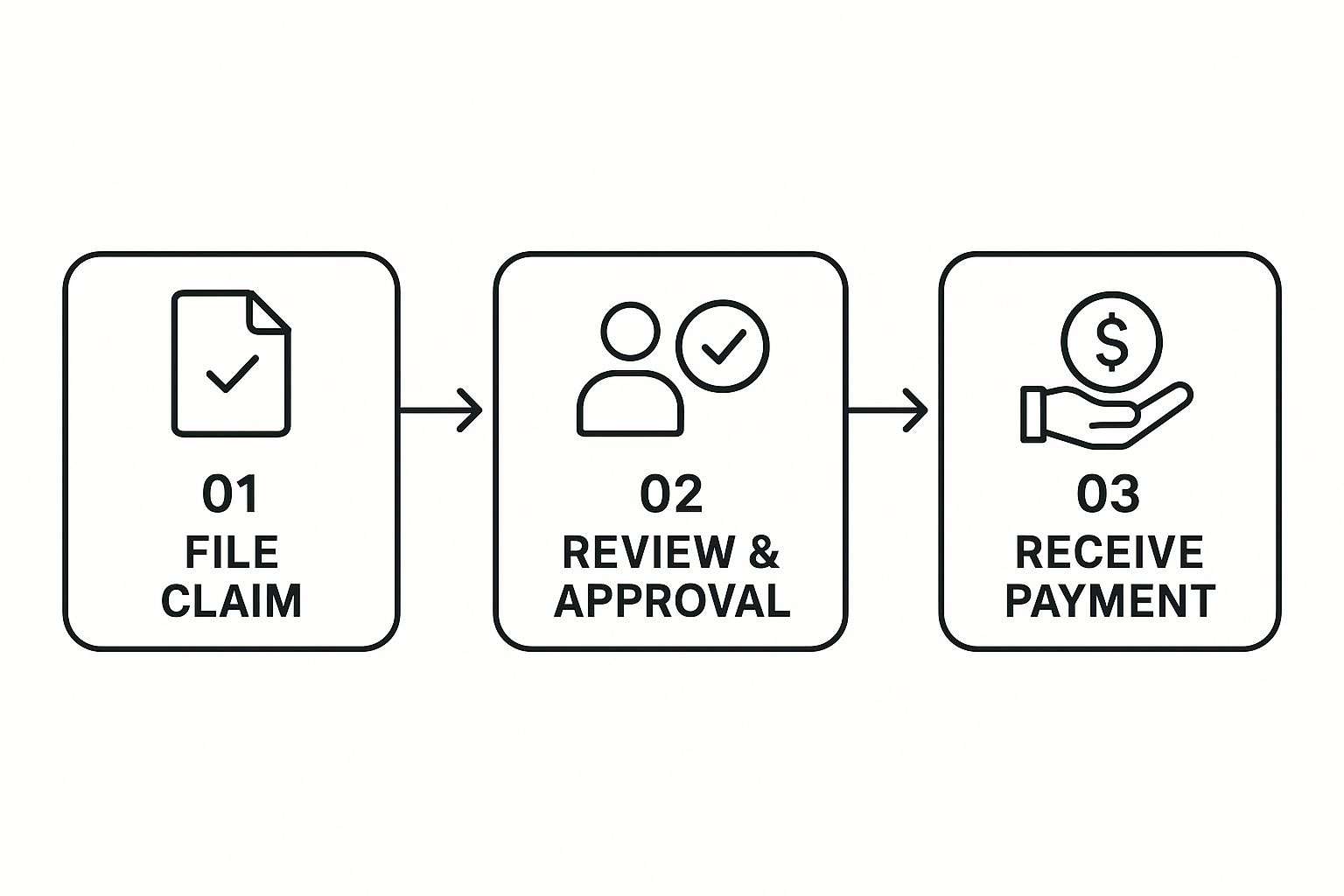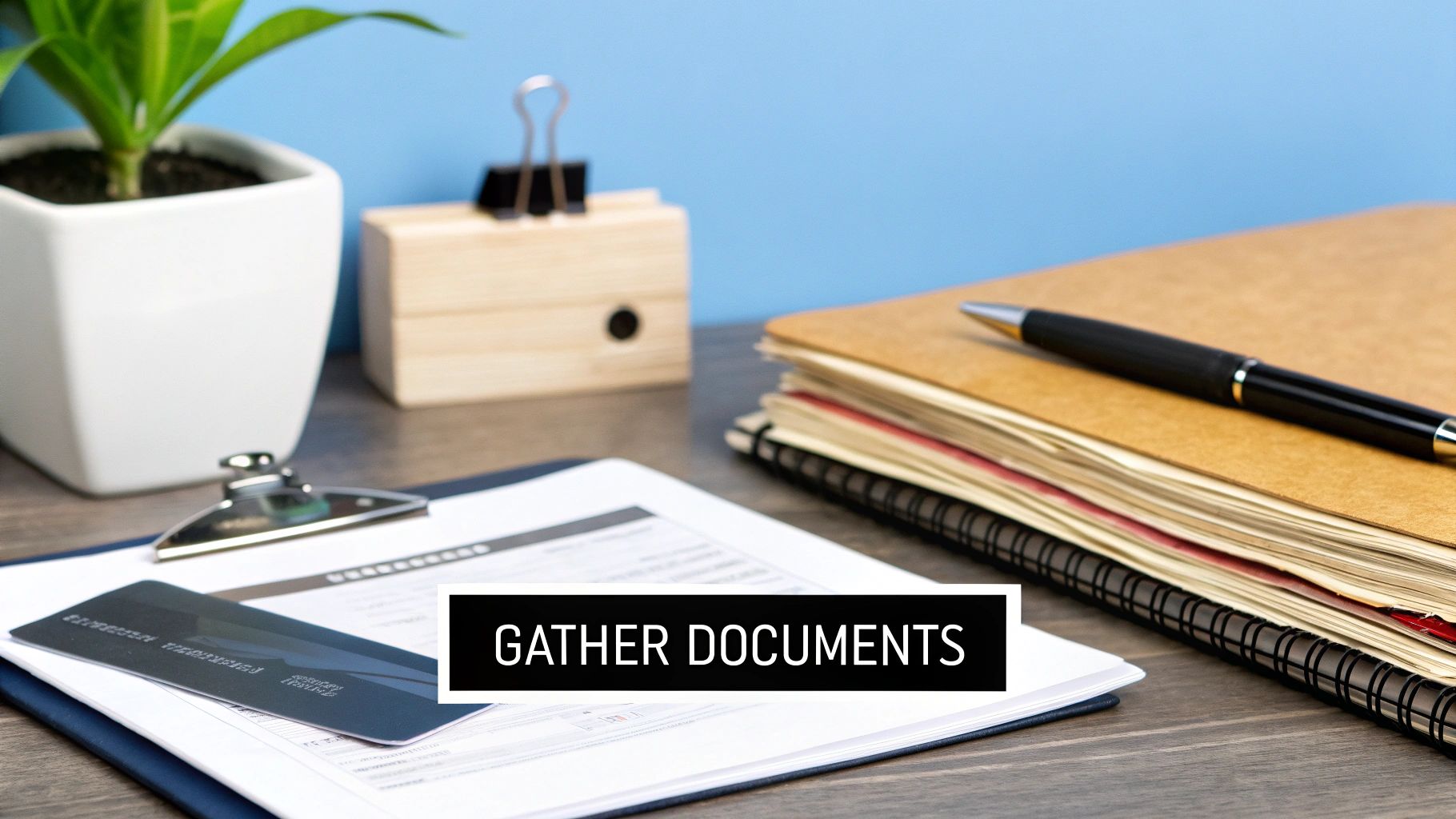Demystifying the Insurance Claim Process Blueprint
The insurance claim process can feel overwhelming. Understanding how it works, however, is key to receiving a timely and fair settlement. This guide breaks down the process into manageable steps, giving you clarity and control during a potentially stressful experience.
Understanding the Claim Lifecycle
The insurance claim process typically involves three stages: filing the claim, review and approval, and receiving payment. The infographic below visualizes this journey.

Each stage builds upon the previous one, highlighting the need for accurate and timely information throughout. A smooth transition between stages is essential for a positive outcome. Understanding what happens at each stage helps manage expectations and ensures a quicker resolution.
Filing Your Claim: The First Crucial Step
The first 24-48 hours after an incident are critical. Gather all necessary information, including police reports (if needed), photos, and witness contact information. Notifying your insurer promptly and providing detailed documentation significantly impacts the process. Maintain records of all communication with your insurance company. For home insurance claims, check out this guide on How to master…. This proactive approach helps ensure a smooth claims experience.
Review and Approval: What Happens Behind the Scenes
After filing, your claim enters the review and approval phase. An adjuster, who assesses the validity and value of claims, will investigate the details. This includes reviewing documentation, possibly conducting site visits, and determining the extent of damage or loss. The adjuster's assessment is crucial in determining the settlement amount. For advice on claim disputes, see these strategies on How to Appeal VA Claim.
Industry trends also influence this process. Over the past five years, the insurance industry has seen significant premium growth, averaging 8 percent annually. This growth reflects the increasing demand for insurance coverage, as detailed in this report on insurance market growth. This surge has led to increased complexities and potentially longer processing times for many claims.
Receiving Payment: The Final Stage
The final stage is receiving your settlement. Once the adjuster completes their assessment, the insurance company issues payment according to your policy. Understanding your policy coverage and deductibles is essential for managing expectations regarding the settlement amount. This knowledge allows policyholders to navigate the process confidently. Carefully review the settlement details before accepting payment.
Crafting a Claim That Demands Attention
Filing an insurance claim isn't about just submitting paperwork; it's about constructing a compelling narrative that captures the attention of insurance professionals. With countless claims vying for attention, yours needs to stand out to be processed efficiently and effectively. This requires understanding the strategies employed by claims professionals and recognizing the psychology behind successful submissions.
Documenting Damage: A Picture Is Worth a Thousand Words, But a Video Is Worth Even More
Effective damage documentation is paramount for a smooth claim journey. Think of it as building a solid case: robust evidence is essential to support your claim. This begins with meticulous documentation that eliminates any ambiguity or room for dispute.
- Photography: Capture crisp, well-lit photographs from various angles. Close-up shots of the specific damage are vital, but remember to include wider shots to establish context. For accurate scale representation, include a ruler or a familiar object within the frame.
- Video: A walkthrough video of the damage, accompanied by a clear narration of what's being shown, adds a layer of authenticity and detail that photos often miss. Ensure your footage is stable, and the audio is clear for optimal clarity.
- Written Descriptions: Complement your visual documentation with detailed written descriptions of the damage. Maintain an objective tone, focusing on factual details rather than emotional responses.
This comprehensive approach furnishes adjusters with a clear, irrefutable account of the damage, bolstering your claim significantly.
The Psychology of Claims: Triggering Priority and Avoiding Scrutiny
Understanding the psychological factors that influence claim prioritization can greatly affect your claim's outcome. A well-presented claim, much like a compelling resume, facilitates faster processing and consideration.
- Clarity and Organization: Present your information in a clear, concise manner. Disorganized or confusing claims can lead to processing delays and unnecessary frustration.
- Professionalism: A professional tone in all communication demonstrates respect and underscores the seriousness of your claim.
- Complete Information: Submitting a complete claim, including all required documentation upfront, showcases your preparedness and minimizes back-and-forth communication, expediting the process.
Conversely, common errors can raise red flags and subject your claim to increased scrutiny. Avoid exaggerating the damage, omitting important details, or presenting inconsistencies in your narrative. These can trigger skepticism, potentially delaying your settlement.
Framing Your Narrative: Turning Facts into a Compelling Story
Presenting your claim effectively involves structuring your narrative in a way that resonates with adjusters, while upholding complete accuracy. This isn't about embellishment or exaggeration; it's about presenting the facts in a clear, logical progression.
- Chronological Order: Structure the events in a clear timeline, beginning with the incident and detailing subsequent actions.
- Focus on Impact: Explain how the incident and the resulting damage have affected you. This humanizes your claim, making it more relatable.
- Use Examples: Illustrate your points with concrete examples from your personal experience, adding weight and relatability to your narrative.
By presenting a compelling and truthful narrative, you can significantly influence your settlement outcome and expedite the overall claim process.
Essential Documentation: Ensuring a Complete Submission
A comprehensive and well-organized claim package is essential for efficient processing. The following table outlines crucial documents you might need, which can vary depending on the nature of your claim:
To ensure a smooth and efficient claims process, it's crucial to have a comprehensive understanding of the necessary documentation. The following table, "Essential Documentation Checklist by Claim Type," offers a detailed comparison of the required documents for various insurance claim types.
Essential Documentation Checklist by Claim Type
| Document Type | Auto Claims | Home Insurance | Health Insurance | Business Insurance |
|---|---|---|---|---|
| Police Report | Often required | Sometimes needed | Usually not required | Situational |
| Photos/Videos | Essential | Essential | Helpful | Essential |
| Medical Records | If applicable | If applicable | Essential | If applicable |
| Bills/Receipts | For repairs, rentals, etc. | For repairs, replacements, etc. | For medical services | For repairs, lost income, etc. |
| Witness Statements | Helpful | Helpful | Situational | Situational |
This table provides a helpful overview of the typical documentation requirements for different claim types. Gathering these documents in advance can significantly streamline the process and minimize potential delays. Having all the necessary information readily available not only demonstrates preparedness but also contributes to a more efficient and potentially faster resolution.
Building a Productive Relationship With Your Adjuster
Your adjuster plays a vital role in the insurance claim process. Their assessment significantly influences your claim's outcome. Building a productive relationship with them isn't just beneficial—it's essential. This involves understanding their perspective and communicating effectively while maintaining your own position.
Understanding the Adjuster’s Role
Adjusters are trained professionals who investigate the validity and value of insurance claims. They act as intermediaries between the insurance company and the policyholder, balancing the interests of both parties. This requires a meticulous approach. They carefully review documentation, may conduct site visits, and ultimately determine the extent of the covered loss. Their evaluation forms the basis for the settlement offer, so presenting a well-organized, factual, and complete claim from the beginning is critical.
Effective Communication Techniques
Building rapport with your adjuster involves clear, respectful communication. Treat the adjuster as a partner in the process. Provide prompt responses to inquiries, maintain professionalism, and demonstrate a willingness to cooperate. For instance, readily provide additional information or documentation upon request. This collaborative approach helps ensure a smoother claims process. However, maintaining respectful persistence is also key to ensuring your needs are addressed.
Preparing for the Assessment Visit
If a site visit is scheduled, adequate preparation is essential. Organize all relevant documents, including photos, videos, and repair estimates. A tidy and accessible damage site also makes a positive impression. This shows respect for the adjuster's time, facilitating a more efficient assessment. It's also a valuable opportunity to directly address any questions the adjuster may have. This proactive approach can significantly expedite the process.
Addressing Disagreements Constructively
Disagreements can sometimes arise during the claims process. Approach these with respectful dialogue and focus on providing evidence to support your position. Clearly articulate your concerns and provide specific examples. This promotes productive discussion. Be open to the adjuster's viewpoint and seek common ground. The goal is to find mutually agreeable solutions.
Recognizing Good Faith and Escalation
Most adjusters work to handle claims fairly and efficiently. However, if you encounter persistent resistance or unreasonable delays, escalating the matter might be necessary. This could involve contacting a supervisor or filing a formal complaint. Meticulous documentation of all communication throughout the entire process is crucial. This record becomes invaluable if further action is required. Knowing when to escalate requires careful judgment and consideration of your specific circumstances.
Furthermore, it’s important to recognize that external market conditions can influence the claim process. In recent years, the global insurance market has seen fluctuations in rates, impacting how insurers manage claims. For example, Marsh’s Global Insurance Market Index reported a 3% decline in global commercial insurance rates in the first quarter of 2025, the third consecutive quarter of decline.

Leveraging Digital Tools for Faster Claim Resolution

Technology is transforming how insurance claims are processed, providing new ways to reach faster resolutions. Understanding how to use these tools effectively is essential for a smooth and efficient claims experience. This section explains how to strategically use digital resources throughout your insurance claim process.
Digital Submission Methods: Choosing Wisely
The digital submission method you choose can significantly impact processing time. Some methods offer speed and efficiency, while others may route your claim to automated systems, potentially delaying human review.
For instance, using a dedicated mobile app designed specifically for claims often provides a more streamlined experience than a general customer service portal. Direct email with an assigned adjuster, when possible, can be more effective than generic online forms. Understanding these nuances helps optimize the digital insurance claim process.
Documenting Evidence: Clear and Compelling Cases
Mobile apps and online portals are now essential tools for documenting evidence. They make it easy to upload photos, videos, and other supporting documents. However, the quality of your evidence remains critical.
Photos should be clear, well-lit, and accurately represent the damage. Use the app's organizational features to present a clear and compelling case to the adjuster. For additional tips on effective documentation, see our guide on car insurance claims.
Tracking Progress and Proactive Communication
Digital tools empower you to track your claim’s progress. Online portals frequently offer real-time updates on claim status. This transparency helps you identify potential bottlenecks.
If your claim stalls, you can proactively contact your adjuster to address the issue, avoiding unnecessary delays and frustration.
AI in Claims Assessment: Understanding the Process
Many insurance companies use AI-powered tools to assess claims. While these tools can improve efficiency, it's important to understand how they work.
Some AI algorithms analyze claims data to identify patterns and potential fraud, which might lead to increased scrutiny for certain claims. A detailed and accurate submission can help avoid being unfairly flagged. Just as you might optimize your resume for applicant tracking systems, understanding how AI assesses claims can help you present your information effectively, ensuring fair evaluation.
To better illustrate the advantages of digital claims processes, let's examine a comparison of digital and traditional claim methods. The following table highlights key differences in processing times, customer satisfaction, and settlement outcomes.
Digital vs. Traditional Claims Processing Comparison
A comparison of processing times, satisfaction rates, and settlement outcomes between digital and traditional claim methods
| Metric | Digital Claims Process | Traditional Claims Process | Difference (%) |
|---|---|---|---|
| Average Processing Time (Days) | 10 | 30 | -66.7% |
| Customer Satisfaction Rate (%) | 85 | 60 | +41.7% |
| Percentage of Claims Settled within 30 Days (%) | 75 | 40 | +87.5% |
As you can see, digital claims processing offers significantly faster processing times, higher customer satisfaction rates, and a greater percentage of claims settled quickly.
The Human Element: Balancing Digital with Direct Contact
Despite the rise of digital tools, human interaction remains essential. If you encounter significant delays or disagree with the adjuster, direct contact is often more effective than relying solely on digital communication.
This is especially important in complex situations or when an AI assessment appears inaccurate. Balancing the use of digital tools with strategic human interaction helps optimize the claims process for a faster, more favorable resolution.
Navigating the Healthcare Claims Labyrinth
Dealing with healthcare insurance claims can often feel overwhelming. The process, filled with specific terminology and complex procedures, can be confusing for even the most experienced policyholders. This guide will provide you with the information necessary to navigate this often complicated system.
Decoding the Explanation of Benefits (EOB)
The Explanation of Benefits (EOB) is a critical document in the insurance claim process. It provides a detailed breakdown of how your insurer processed your claim, including which services were covered, the amounts paid, and any remaining patient responsibility. Understanding the EOB is essential for identifying potential errors.
These errors could significantly impact your finances. For example, a service might be incorrectly listed as not covered, resulting in an unexpected bill. Carefully reviewing your EOB is the first step in preventing billing errors. This careful review could save you thousands of dollars.
Handling Claim Denials: Strategies for Success
Claim denials can be frustrating, but they are not necessarily the end of the road. Understanding how to appeal a denied claim can significantly increase your chances of a successful outcome. Using clear, concise language and providing supporting documentation like medical records or doctor's notes can greatly improve your appeal's success rate.
Some studies indicate that using specific language in your appeal can improve success rates by over 60%. You might find this article helpful: How to master car insurance claims. This highlights the importance of a well-structured and persuasive appeal. Persistence and proper documentation are key to turning denials into approvals.
Managing Network Complications and Multiple Policies
Navigating network complexities and coordinating multiple insurance policies adds another layer of complexity to the claims process. Understanding your policy's network requirements and the interplay of different plans is vital for maximizing your coverage.
For example, if you have both primary and secondary insurance, coordinating claims between both insurers ensures all eligible expenses are reimbursed. This coordination prevents gaps in coverage and unexpected out-of-pocket costs. It ensures all parties contribute their appropriate share.
Proactive Steps to Prevent Claim Rejections
Many claim rejections are due to preventable errors. Providing accurate patient information, verifying insurance coverage before receiving services, and understanding pre-authorization requirements are important proactive steps. These steps can significantly reduce claim denials and the headaches that accompany them.
Maintaining organized records of medical expenses and insurance communications can also help. Compliance Automation offers digital tools for streamlining record keeping and claim resolution. This organized approach will make the entire process much smoother and less stressful.
The insurance claim process is constantly changing, especially in healthcare. The recent pandemic, for instance, has spurred a move towards digital health solutions and pandemic-resilient policies, as discussed in more detail on this page about healthcare claims trends. Staying informed about current trends and best practices in healthcare claims management is essential in today’s evolving healthcare environment.
Turning Claim Disputes Into Settlement Victories

Not every insurance claim proceeds without a hitch. Disputes sometimes occur, and understanding how to handle these situations can be the deciding factor between a fair settlement and a disappointing result. This section provides you with the strategies needed to turn claim disputes into victories.
Recognizing and Countering Lowball Tactics
One common obstacle in the insurance claim process is the "lowball" offer. This occurs when the insurance company presents a settlement substantially lower than the actual claim value. Recognizing this tactic is the crucial first step. For example, if your car repair estimate is $5,000 and the insurer offers $2,000, this is a likely lowball offer.
The next step is to counter the offer effectively. This requires compelling evidence. Detailed repair estimates, medical bills, and lost wage documentation are powerful counterarguments. Methodically presenting this evidence reinforces your position and demonstrates the true value of your claim.
The Psychology of Negotiation: Leveraging Ethical Persuasion
Negotiation is key to resolving claim disputes. Understanding the psychology of these interactions can greatly improve your outcome. One effective strategy is presenting your case logically and calmly, focusing on facts and evidence rather than emotions.
Additionally, highlighting the inconvenience and disruption caused by the incident can underscore the situation's impact. However, maintaining ethical conduct throughout the negotiation is critical. Misrepresenting facts or exaggerating damages can damage your credibility and harm your case.
Exploring Your Options: From Internal Reviews to Legal Action
If negotiation doesn't yield a satisfactory settlement, several options remain. Many insurance companies offer internal review processes. This allows you to appeal the initial decision to a higher authority within the company. This can be an effective way to resolve disputes without legal action. For more information on average claim amounts, you might find this resource helpful: How to master….
If the internal review is unsuccessful, filing a complaint with your state's insurance regulatory agency is another option. These agencies monitor insurance company practices and investigate complaints of unfair treatment. As a last resort, you can pursue legal action. Consulting with an attorney specializing in insurance claims can clarify your legal rights and the appropriate remedies.
Case Studies: Turning Denials into Settlements
Examining successful dispute resolutions offers valuable insights into effective strategies. One common scenario involves a denied auto insurance claim due to disputed liability. By gathering witness statements, police reports, and dashcam footage, the claimant successfully proved their version of events, overturned the initial denial, and received a fair settlement.
In another case, a homeowner’s claim for water damage was initially undervalued. By obtaining independent assessments from contractors, the homeowner proved the true extent of the damage and secured a significantly higher settlement. These examples illustrate how persistence, thorough documentation, and strategic presentation can turn initial rejections into positive outcomes.
Mastering Documentation: The Foundation of a Strong Claim
Thorough documentation is essential throughout the insurance claim process, especially when disputes arise. Keep detailed records of all communication with the insurance company, including phone calls, emails, and letters. This record establishes a clear timeline of events and serves as evidence of your efforts to resolve the matter.
Maintain meticulous records of all claim-related expenses, such as repair bills, medical receipts, and travel expenses, to demonstrate the incident's financial impact. This detailed record provides undeniable evidence to support your claim and strengthen your negotiating position.
Comments are closed.